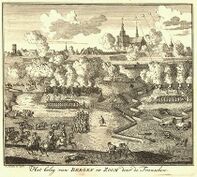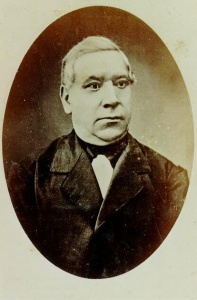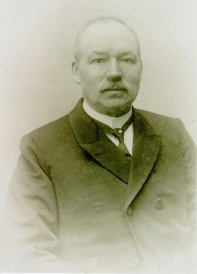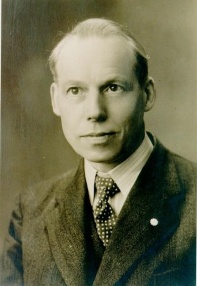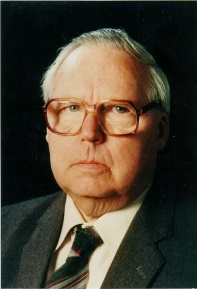Benutzer:Andriessen/en/History: Unterschied zwischen den Versionen
Keine Bearbeitungszusammenfassung |
Keine Bearbeitungszusammenfassung |
||
| Zeile 26: | Zeile 26: | ||
Zelle 4='''[[Andriessen, Gabriël/de|Gabriël Andriessen]] (29.10.1818 – 11.7.1884)''' | Zelle 4='''[[Andriessen, Gabriël/de|Gabriël Andriessen]] (29.10.1818 – 11.7.1884)''' | ||
Gabriël Andriessen was unfortunately lame and could not keep up with the farm and it would certainly not be easy for him to be an innkeeper either. However, he was a good student and it was decided to choose a suitable profession for him. He would leave for Brussels to train as a "watchmaker", according to tradition he had lodgings with a distant relative. When he returned to Bergen op Zoom he started his own company and on [[18. Juli|18. July]] [[1848/de|1848]] registered himself in the guarantee register as a merchant of gold and silver watches. Shortly afterwards he was able to rent his own building in the Engelse Staat number 42. This building called "Romeijn" dated from [[1610/de|1610]] and it was also here that his son and later successor Dionisius Cornelis was born. However, the building was demolished in [[1889/de|1889]] to make way for a larger building. In [[1859/de|1859]] Gabriel and his family moved to the Bosstraat to set up a larger shop. (now Bosstraat 1) In [[1884/de|1884]] Gabriël dies, a year earlier '''Dionisius Cornelis Andriessen''' had already taken over the company. The deed of the takeover of the goods from that time gives a nice picture of what was in stock at that time. | Gabriël Andriessen was unfortunately lame and could not keep up with the farm and it would certainly not be easy for him to be an innkeeper either. However, he was a good student and it was decided to choose a suitable profession for him. He would leave for Brussels to train as a "watchmaker", according to tradition he had lodgings with a distant relative. When he returned to Bergen op Zoom he started his own company and on [[18. Juli|18. July]] [[1848/de|1848]] registered himself in the guarantee register as a merchant of gold and silver watches. Shortly afterwards he was able to rent his own building in the Engelse Staat number 42. This building called "Romeijn" dated from [[1610/de|1610]] and it was also here that his son and later successor Dionisius Cornelis was born. However, the building was demolished in [[1889/de|1889]] to make way for a larger building. In [[1859/de|1859]] Gabriel and his family moved to the Bosstraat to set up a larger shop. (now Bosstraat 1) In [[1884/de|1884]] Gabriël dies, a year earlier '''Dionisius Cornelis Andriessen''' had already taken over the company. The deed of the takeover of the goods from that time gives a nice picture of what was in stock at that time.<br><br><br><br><br><br>| | ||
Zelle 5=<center>[[Bild:Dyonisius Cornelis Andriessen.jpg|197px]]</center><br>| | Zelle 5=<center>[[Bild:Dyonisius Cornelis Andriessen.jpg|197px]]</center><br>| | ||
| Zeile 32: | Zeile 32: | ||
Dionisius Cornelis turned out to be not only a talented watchmaker but also very artistic. As a young boy he already showed himself to be a gifted draftsman and at first it was not at all certain whether he would be able to take over his father's business, the clientele doubted whether he was as good as his father. He had rather modern ideas. For example, he was a strong advocate of the new flat French watches instead of the thick heavy English clocks. His first job was not as a watchmaker but he was appointed by the municipal authorities as "supervisor of hand drawing in the Stadsteekenschool", where he himself had been a pupil. After three years he decided to call it a day and resigned in [[1875/de|1875]] and went to work in his father's business. He increasingly takes over the work and since his marriage in [[1881/de|1881]], there is increasing talk of taking over the company, which then actually happens in [[1883/de|1883]]. | Dionisius Cornelis turned out to be not only a talented watchmaker but also very artistic. As a young boy he already showed himself to be a gifted draftsman and at first it was not at all certain whether he would be able to take over his father's business, the clientele doubted whether he was as good as his father. He had rather modern ideas. For example, he was a strong advocate of the new flat French watches instead of the thick heavy English clocks. His first job was not as a watchmaker but he was appointed by the municipal authorities as "supervisor of hand drawing in the Stadsteekenschool", where he himself had been a pupil. After three years he decided to call it a day and resigned in [[1875/de|1875]] and went to work in his father's business. He increasingly takes over the work and since his marriage in [[1881/de|1881]], there is increasing talk of taking over the company, which then actually happens in [[1883/de|1883]]. | ||
Two girls have already been born in the family, but a son as successor only presents himself in [[1886/nl|1886]] Cornelis Johannes Gabriël. Eventually the family consists of 9 children, 5 of whom end up in the jewelry trade. Three sons became clergymen, '''[[Andriessen, Piet (1)/nl|Piet Andriessen]]''' first became a watchmaker and later a missionary priest in Bondo Congo. As the family grew, the company also grew; in addition to watches, the sale of gold and silverware was also taken up. In addition to the building on Bosstraat, the buildings Grote Markt 22 and 22a were purchased. D.C. Andriessen not only expanded the company, but he was also very active socially, including in the R.K. Poor Board and the board of the poorhouse, which is still known as "de Blok". His sudden death was not only a shock for the family but apparently also a loss for the city, given the reporting in the newspapers of those days. | Two girls have already been born in the family, but a son as successor only presents himself in [[1886/nl|1886]] Cornelis Johannes Gabriël. Eventually the family consists of 9 children, 5 of whom end up in the jewelry trade. Three sons became clergymen, '''[[Andriessen, Piet (1)/nl|Piet Andriessen]]''' first became a watchmaker and later a missionary priest in Bondo Congo. As the family grew, the company also grew; in addition to watches, the sale of gold and silverware was also taken up. In addition to the building on Bosstraat, the buildings Grote Markt 22 and 22a were purchased. D.C. Andriessen not only expanded the company, but he was also very active socially, including in the R.K. Poor Board and the board of the poorhouse, which is still known as "de Blok". His sudden death was not only a shock for the family but apparently also a loss for the city, given the reporting in the newspapers of those days.<br>| | ||
| Zeile 38: | Zeile 38: | ||
Zelle 8='''[[Andriessen, Cornelis/de|Cornelis Andriessen]] (20.4.1886 – 25.4.1982)''' | Zelle 8='''[[Andriessen, Cornelis/de|Cornelis Andriessen]] (20.4.1886 – 25.4.1982)''' | ||
It was quite a challenge for the young Cornelis and his brother Antoine to take over their father's company at such a young age. Admittedly, they had received a solid education at home and were good at their trade. Cornelis would take over the watch department and the optics department. Antoine was given the management of the goldsmith's shop (which can still be seen at Grote Markt 25, now a restaurant). The company was split into two separate businesses. The oldest part of the shop on Bosstraat was converted into a house for the widow, and the building on Grote Markt "St. Jacob" was expanded with the building next door "De Ketel". The old characteristic shop front was expanded entirely in style according to the original design by Architect van Genk. In [[1917/nl|1917]] the outdoor clock was hung on the facade. It was ordered from the firm [[Bahnzeit]] in [[Glashütte]] near Dresden in Germany. This small town is still known today for its watchmaking industry. '''[[Andriessen, Jacques/nl|Jacques Andriessen]]''' , Cornelis' youngest brother, but also his brother-in-law '''[[Verhagen, Cornelis|Cor. Verhagen]]''' were able to complete their education there at the [[Deutsche Uhrmacherschule Glashütte|Deutsche Uhrmacherschule]]. If circumstances prevented Cornelis from attending this famous school, his son and successor '''Bernard Andriessen''' was able to do so. However, Cornelis was very gifted and a solid craftsman. The seconds regulator he built is a fine example of this. His dedication to the profession was reflected in his involvement in vocational training in the Netherlands, for many years and into old age. Many watchmakers took their exams with him. He was also known beyond the borders for his work as a board member of the Union Horlogère [[Alpina]]. He also had a special watch spring he had developed patented. His great hobby was billiards, which he often took as seriously as his profession. At the age of 80, he did not mind going on holiday to his son Piet in America. | It was quite a challenge for the young Cornelis and his brother Antoine to take over their father's company at such a young age. Admittedly, they had received a solid education at home and were good at their trade. Cornelis would take over the watch department and the optics department. Antoine was given the management of the goldsmith's shop (which can still be seen at Grote Markt 25, now a restaurant). The company was split into two separate businesses. The oldest part of the shop on Bosstraat was converted into a house for the widow, and the building on Grote Markt "St. Jacob" was expanded with the building next door "De Ketel". The old characteristic shop front was expanded entirely in style according to the original design by Architect van Genk. In [[1917/nl|1917]] the outdoor clock was hung on the facade. It was ordered from the firm [[Bahnzeit]] in [[Glashütte]] near Dresden in Germany. This small town is still known today for its watchmaking industry. '''[[Andriessen, Jacques/nl|Jacques Andriessen]]''' , Cornelis' youngest brother, but also his brother-in-law '''[[Verhagen, Cornelis|Cor. Verhagen]]''' were able to complete their education there at the [[Deutsche Uhrmacherschule Glashütte|Deutsche Uhrmacherschule]]. If circumstances prevented Cornelis from attending this famous school, his son and successor '''Bernard Andriessen''' was able to do so. However, Cornelis was very gifted and a solid craftsman. The seconds regulator he built is a fine example of this. His dedication to the profession was reflected in his involvement in vocational training in the Netherlands, for many years and into old age. Many watchmakers took their exams with him. He was also known beyond the borders for his work as a board member of the Union Horlogère [[Alpina]]. He also had a special watch spring he had developed patented. His great hobby was billiards, which he often took as seriously as his profession. At the age of 80, he did not mind going on holiday to his son Piet in America.<br>| | ||
Version vom 2. Februar 2025, 21:59 Uhr
|
